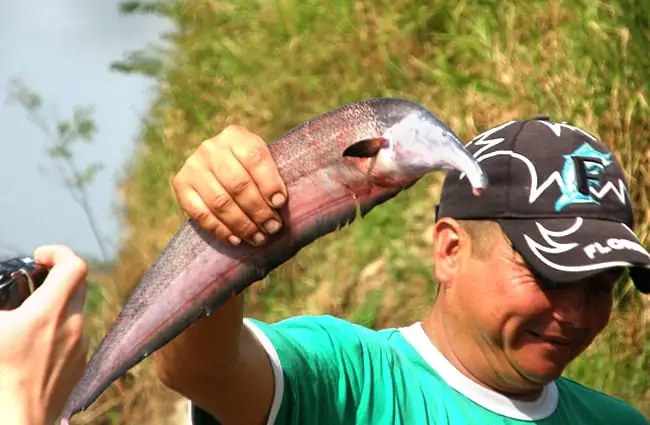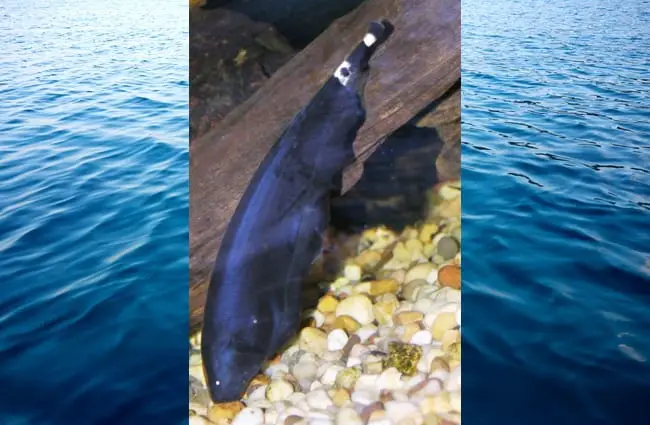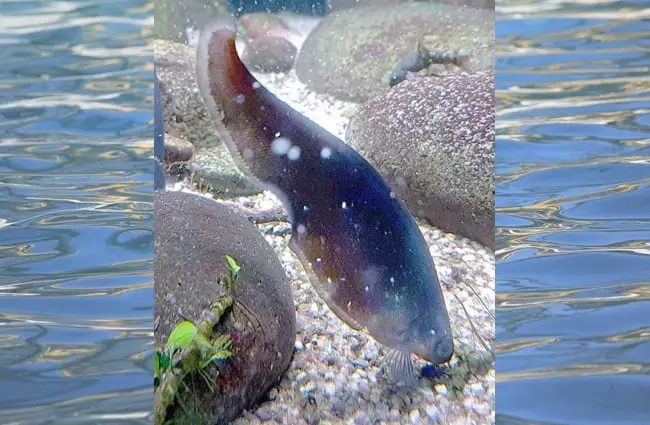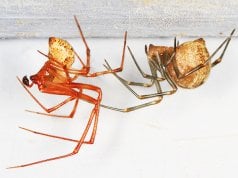The aquatic world harbors creatures of incredible adaptation and unique beauty. Among these, the knifefish stands out as a truly remarkable group. Often described as living knives, these fish possess an elongated body, undulating swimming style, and a fascinating suite of behaviors. This article delves into the world of knifefish, exploring their biology, habitat, behavior, and place in the ecosystem, as well as some interesting facts and practical advice.

What are Knifefish?
Knifefish are a diverse group of ray-finned fish belonging to the order Gymnotiformes. They are characterized by their long, laterally compressed bodies, which can resemble a knife or blade, hence their common name. These fish lack pelvic fins and possess an anal fin that runs nearly the entire length of their body. This extended fin provides the primary means of propulsion, creating a characteristic undulating movement as they swim. There are over 100 species of knifefish, each exhibiting subtle variations in size, color, and behavior. Some of the most well-known species include the Black Ghost Knifefish (Apteronotus albifrons), the Royal Knifefish (Chitala chitala), and the African Brown Knifefish (Gymnarchus niloticus).
Physical Characteristics
The size of knifefish varies significantly depending on the species. Some species remain relatively small, reaching only a few inches in length, while others can grow to over three feet. Their bodies are typically dark in color, often black, brown, or gray, providing camouflage in their murky environments. Many species exhibit subtle patterns or markings, and some, like the Black Ghost Knifefish, have a striking white band along their flanks. A key physical characteristic is their ability to generate a weak electric field, used for navigation, communication, and prey detection. They achieve this using specialized cells called electrocytes, creating a biological “sixth sense.”
Habitat and Distribution
Knifefish are primarily found in freshwater habitats in South America and Africa. They inhabit a variety of environments, including rivers, streams, lakes, and flooded forests. They prefer slow-moving or stagnant waters with plenty of vegetation and hiding places. The Amazon and Orinoco basins in South America are particularly rich in knifefish diversity, while the Nile River and other African waterways support several species. The specific habitat requirements vary depending on the species. Some prefer heavily vegetated areas, while others are more common in open water. The water quality is also important, with most species preferring slightly acidic and soft water.

Diet and Feeding Behavior
Knifefish are carnivorous predators, feeding on a variety of small animals. Their diet typically consists of insects, crustaceans, worms, and small fish. They use their weak electric field to detect prey, even in murky water or darkness. Once prey is located, they quickly ambush it, using their sharp teeth to secure it. They are opportunistic feeders, meaning they will eat whatever is available. Some species also consume plant matter, such as algae or detritus. Interestingly, the Black Ghost Knifefish is known to sometimes feed on smaller knifefish.
Evolutionary History
The evolutionary history of knifefish is a fascinating tale of adaptation. The earliest ancestors of knifefish are believed to have originated in South America during the Cretaceous period, over 100 million years ago. Over time, these fish diversified and spread throughout the continent, eventually reaching Africa through a combination of continental drift and dispersal events. The development of their elongated body shape and extended anal fin is thought to have been driven by the need to navigate complex aquatic environments, such as flooded forests and tangled vegetation. The evolution of their electric sense is also a key adaptation, allowing them to thrive in dark or murky waters where vision is limited. Genetic studies have revealed that the African and South American knifefish lineages are distinct, suggesting that they have been separated for millions of years.

Reproduction and Life Cycle
The reproductive behavior of knifefish varies depending on the species. Most species are egg-layers, releasing their eggs into the water column or depositing them on vegetation. The eggs are often guarded by one or both parents, who protect them from predators. The incubation period varies depending on the water temperature and species, but typically lasts several days. Once the eggs hatch, the larvae are small and translucent, feeding on tiny invertebrates. The larvae gradually grow and develop, eventually maturing into adults. Some species exhibit parental care, such as building nests or providing food for their young. The lifespan of knifefish varies depending on the species, but most live for several years.
Ecological Role and Interactions
Knifefish play an important role in their ecosystems. As predators, they help to control populations of small invertebrates and fish. They also serve as a food source for larger predators, such as birds, reptiles, and larger fish. Their unique electric sense can influence the behavior of other animals, creating complex interactions within the ecosystem. Some species of knifefish are known to engage in cooperative hunting, working together to capture prey. They also interact with other fish species, sometimes forming symbiotic relationships. For example, some knifefish are known to clean parasites off of other fish.

Knifefish and Humans
Knifefish have a long history of interaction with humans. In some cultures, they are considered a delicacy and are harvested for food. They are also popular in the aquarium trade, prized for their unique appearance and behavior. However, the aquarium trade can also pose a threat to wild populations if not managed sustainably. Knifefish have also been studied by scientists for their unique electric sense, which has inspired the development of new technologies. For example, researchers are exploring the possibility of using knifefish-inspired sensors for underwater navigation and object detection.
Encountering a Knifefish in the Wild
If you encounter a knifefish while hiking or exploring near freshwater habitats, it is best to observe it from a distance. Do not attempt to handle or disturb the fish, as this could cause stress or injury. Remember that knifefish are predators and may bite if threatened. It is also a good reminder to be mindful of the delicate ecosystems these creatures inhabit and to avoid any actions that could harm them or their habitat.
Caring for Knifefish in Captivity
For zookeepers or aquarium enthusiasts, caring for knifefish requires careful attention to their specific needs. They require a large tank with plenty of hiding places, such as plants or driftwood. The water should be kept clean and well-oxygenated, with a temperature between 72 and 82 degrees Fahrenheit. They are sensitive to water quality, so regular water changes are essential. Their diet should consist of live or frozen foods, such as insects, crustaceans, and small fish. They are nocturnal animals, so they prefer dim lighting. Avoid overcrowding the tank, as this can cause stress and disease.

Fascinating Facts
- Knifefish can generate an electric field of up to 200 millivolts.
- Some species of knifefish can regenerate damaged fins.
- The Black Ghost Knifefish is known for its ability to swim backwards.
- African Brown Knifefish are one of the largest freshwater fish in Africa.
- Knifefish are more closely related to carp and catfish than to other electric fish.
The world of knifefish is a testament to the power of evolution and the incredible diversity of life on Earth. These remarkable creatures continue to fascinate scientists and nature enthusiasts alike, offering valuable insights into the complexities of aquatic ecosystems and the wonders of the natural world.

![Red Angus Closeup of a beautiful Red Angus cowPhoto by: U.S. Department of Agriculture [pubic domain]https://creativecommons.org/licenses/by/2.0/](https://animals.net/wp-content/uploads/2020/03/Red-Angus-4-238x178.jpg)




![Red Angus Closeup of a beautiful Red Angus cowPhoto by: U.S. Department of Agriculture [pubic domain]https://creativecommons.org/licenses/by/2.0/](https://animals.net/wp-content/uploads/2020/03/Red-Angus-4-100x75.jpg)

